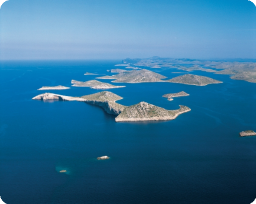

Kornati National Park
Kornati National Park  Modri Bok: A rectangle of blueness
Modri Bok: A rectangle of blueness
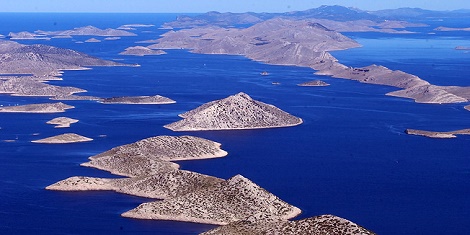
The majority of boaters come to the Kornati islands, Croatia's largest island labyrinth, during the summer when there is so much sun that it tends to hide rather than reveal. The sunbathed Kornati islands, full of bare, white dazzling flagstones, aren't much of a visual experience. When I first sailed into Modri Bok, a bay situated in the middle of the southern side of the Kornati islands, it was a hot summer around noon and I asked myself, blinking: "What is there to see?" Years later, I returned to Modri Bok and Kornati during more appropriate seasons, with the sun in a different position, and realised that this bare and wide bay was ideal for dreaming about holy simplicity.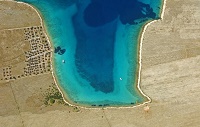 In Modri Bok, you have an opportunity to make friends with the blueness, because in this bay there is not even a shade of turquoise, suggesting that the depth beneath us is sufficient enough for good anchoring and relaxed swimming. The bay is deep, except at the edges, but unlike the depths of the open sea is tame, domestic and safe.
In Modri Bok, you have an opportunity to make friends with the blueness, because in this bay there is not even a shade of turquoise, suggesting that the depth beneath us is sufficient enough for good anchoring and relaxed swimming. The bay is deep, except at the edges, but unlike the depths of the open sea is tame, domestic and safe.
First of all there is Strižnji Rt, the headland that closes Modri Bok and provides good protection to the bay from the mistral. Its sloping coastline, unlike other Adriatic bays, does not follow the line of a funnel, but rather borders it by creating the shape of an open rectangle, and provides a feeling of being in a spacious blue living room. The small island of Bisaga in front of the bay serves as extra protection, along with Golić or Mala Bisaga to the west of it. Unlike in Strižnja and Kravljačica, the nearest Kornati bays to it, there are no houses in Modri Bok, which means that a stay in this bay provides a sense of intimacy that is becoming increasingly rare and whose gentleness is best experienced under a special light: the early morning hours and moments when day slowly turns to night.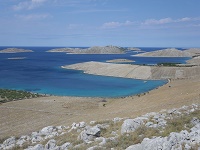 Spring is especially beautiful on the Kornati islands. In Modri Bok in April and May, the blueness of the sea and whiteness of the stone is complemented by the fresh greenness of the first vegetation, purple rows of flowers and yellow lines of the Spanish broom shrubs. However, this magical fragrant image of Modri Bok is not without a discreet human signature; high uphill from the sea and all the way to the top of Kornati, there extends a large straight dry stone wall, which is one of the largest I have encountered. The locals call it the wall, and it separates flocks of sheep preventing them from getting mixed. Even today, it serves its purpose and is at the same time a heritage monument of dry stone which we have only recently been trying to get protection for.
Spring is especially beautiful on the Kornati islands. In Modri Bok in April and May, the blueness of the sea and whiteness of the stone is complemented by the fresh greenness of the first vegetation, purple rows of flowers and yellow lines of the Spanish broom shrubs. However, this magical fragrant image of Modri Bok is not without a discreet human signature; high uphill from the sea and all the way to the top of Kornati, there extends a large straight dry stone wall, which is one of the largest I have encountered. The locals call it the wall, and it separates flocks of sheep preventing them from getting mixed. Even today, it serves its purpose and is at the same time a heritage monument of dry stone which we have only recently been trying to get protection for.
By climbing the wall, you are able to observe Modri Bok from a seagull's perspective and more fully appreciate the square surface of its tamed sea. If you want to meet the locals, you need to remember that a well-worn path extends from Modri Bok to nearby Strižnja and a little further on to Kravljačica. However, the persistence of Kornati's locals and their ancestors is also evident from other testimonials to life on the Kornati islands. Two island fields are situated above Modri Bok, Strižnja and Kravljačica: the Željkovac (Želikovac) plateau with its large olive grove, and Tarac, where there was once a vineyard.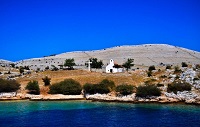 The Church of Our Lady of Tarac (dedicated to the Visitation of the Blessed Virgin Mary), which is situated here, was built on a 58-metre-high headland. The small, white painted church with a single tree on the bare Kornati land is part of my regular pilgrimage towards holy simplicity. On the first Sunday in July, one of the most beautiful church festivals is held here. Hundreds of boats sail in procession from Murter so that people can thank Our Lady for their successful navigation through the Kornati sea. The church was built in the 12th century on the foundations of an early Christian basilica, of which only the apse was left behind, and which dates back to the 6th century and the Byzantine era of Justinian's reconquest. All this shows that the Kornati islands are only a "wilderness" at first sight, as underneath there exist deep layers of history that experts have yet to discover, and the administration of the National Park to make sense of. This is also evident in Tureta, a fort situated not far from Our Lady of Tarac. It was built in the 6th century between the periods of Late Antiquity and the Early Middle Ages in the era of the Emperor Justinian, and was used to control navigation in the re-established channel in this part of the Adriatic. The Kornati Tureta is part of a larger system of Byzantine marine fortifications in the Adriatic.
The Church of Our Lady of Tarac (dedicated to the Visitation of the Blessed Virgin Mary), which is situated here, was built on a 58-metre-high headland. The small, white painted church with a single tree on the bare Kornati land is part of my regular pilgrimage towards holy simplicity. On the first Sunday in July, one of the most beautiful church festivals is held here. Hundreds of boats sail in procession from Murter so that people can thank Our Lady for their successful navigation through the Kornati sea. The church was built in the 12th century on the foundations of an early Christian basilica, of which only the apse was left behind, and which dates back to the 6th century and the Byzantine era of Justinian's reconquest. All this shows that the Kornati islands are only a "wilderness" at first sight, as underneath there exist deep layers of history that experts have yet to discover, and the administration of the National Park to make sense of. This is also evident in Tureta, a fort situated not far from Our Lady of Tarac. It was built in the 6th century between the periods of Late Antiquity and the Early Middle Ages in the era of the Emperor Justinian, and was used to control navigation in the re-established channel in this part of the Adriatic. The Kornati Tureta is part of a larger system of Byzantine marine fortifications in the Adriatic.
About the author:
Josip Antić was born in Šibenik, and Šibenik Bay was the first sea that he set sail in. As a journalist, he worked for numerous Croatian daily and weekly newspapers and portals, reporting during both war and peace from Parliament and the streets. He also spent a number of years as an editor. He remembers only those articles and reports he published about the sea and from the sea, spending time with fishermen, yachtsmen, sailors, caulkers and seagulls. For more than 10 years he was the editor of a nautical magazine.
He lives and works in Zagreb and sails in the Adriatic when he is able to.
Video
Current news
 Macrocruise charter agency
Additional discount on the boat rental price of betw
Macrocruise charter agency
Additional discount on the boat rental price of betw


























